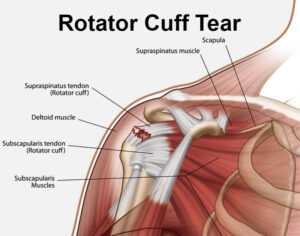Pain in the shoulder brings many people to the doctor, which sometimes results in an MRI. A rotator cuff tear is a common diagnosis made, but the problem can actually be coming from somewhere else, in spite of what imaging reveals. Because the shoulder joint is the most mobile joint in the body, a harmony of muscle contraction is required to produce pain free mobility. Muscle and fascial tightness in and around the shoulder, chest and upper back will impact this harmony of motion, affecting the way the shoulder joint moves. As well as these areas, muscles and joints of the neck, as well as mal-positioned discs can also impact the way the shoulder joint moves. Both can be the true underlying source of pain. A myofascial trained physical therapist is especially equipped at evaluating muscle/fascial restriction in these areas.
